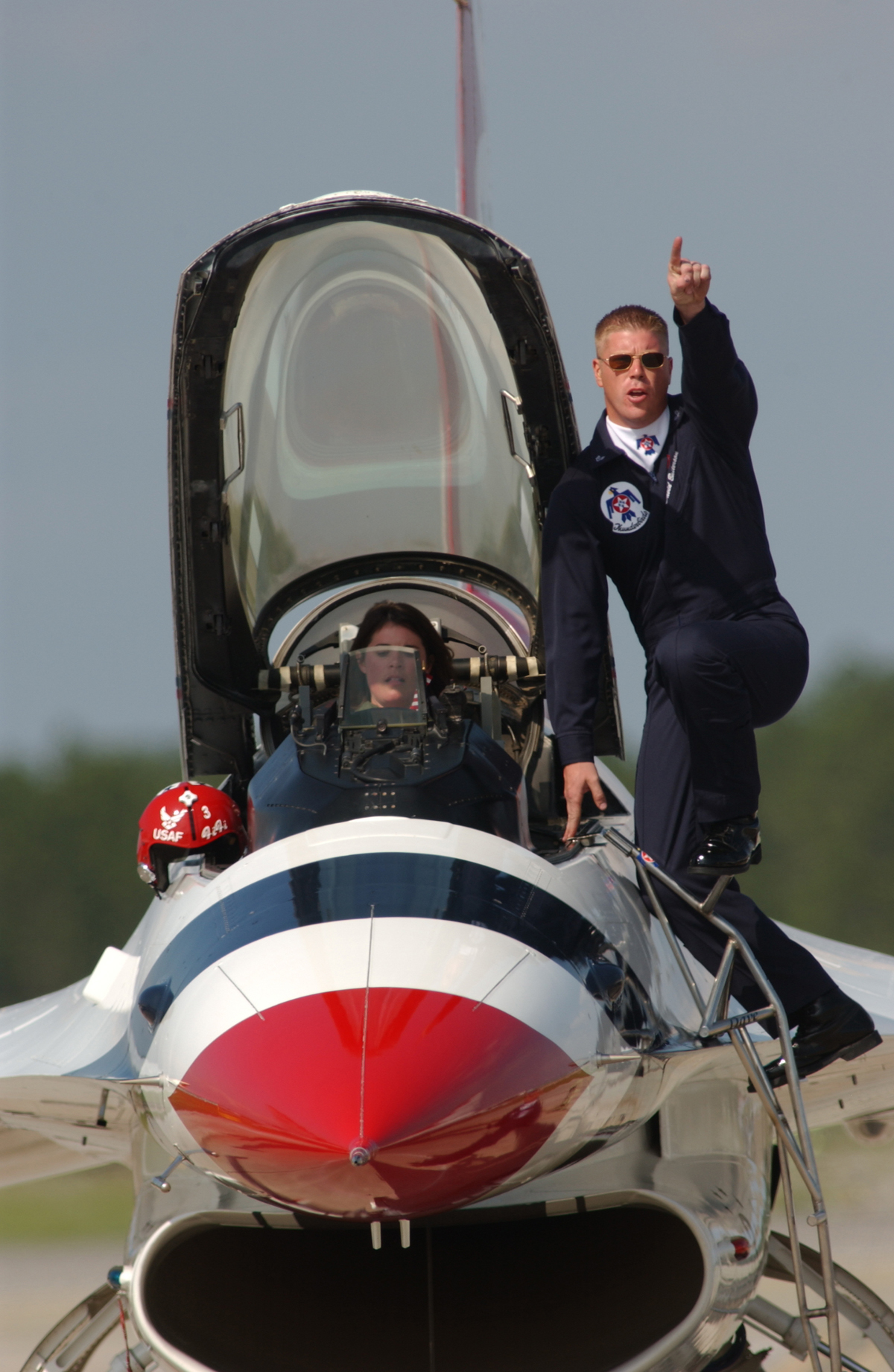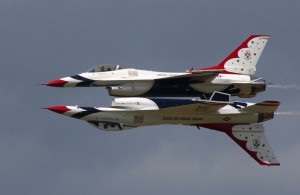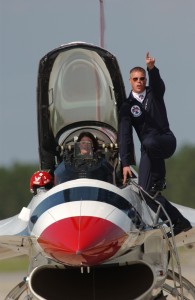
Staff Sgt. Dave Batterson, 2006 dedicated crew chief for Maj. Nicole Malachowski, Thunderbird #3, calls out the one-minute warning to engine start up at an air show at Tyndall Air Force Base, Fla. in April 2006.
By Bill Stansbeary
The Thunderbirds, the U.S. Air Force air demonstration squadron, are scheduled to perform their precision aerial maneuvers at 70 air shows as the Air Force marks its 60th anniversary. The Thunderbirds will perform in 22 states and nine countries. It will be the first time the team has performed in Europe since 9/11.
The first official USAF air demonstration team was designated the 3600th Air Demonstration Unit and was activated in 1953 at Luke Air Force Base in Phoenix. “Thunderbirds” was soon adopted as the unit name because of the strong Indian culture and folklore of the area. Seven officers and 22 enlisted men were selected for the first demonstration team.
Major Dick Catledge, a training squadron commander at the base, was chosen as the team leader. Twin brothers, Bill and Buck Pattillo, were selected to fly left and right wing positions. Captain Bob Kanaga was selected to fly the difficult position of slot, behind the leader. The spare pilot would be Capt. Bob McCormick, who had demonstration team experience with the “Sabre Dancers.”
The first aircraft used was the straight-wing F-84G Thunderjet, built by Republic Aviation. The original demonstration sequence consisted of a series of formation aerobatics lasting 15 minutes. The swept-wing F-84F Thunderstreak was selected as the team aircraft in 1955, and was modified with smoke tanks and red, white and blue drag chutes.
In 1956, the Thunderbirds became the world’s first supersonic aerial demonstration team, with the F-100 Super Sabre, and the team moved to Nellis Air Force Base, Nev. The F-105B Thunderchief performed in only six shows in 1964, and the Thunderbirds quickly went back to the F-100D.
In 1969, the team began the conversion to the bigger, heavier and more powerful McDonnell Douglas F-4E Phantom II, which used two General Electric J-79 turbojet engines with afterburners. A fuel crisis in 1974 brought about the need for the efficient Northrop T-38A Talon supersonic jet trainer. Five T-38s used the same amount of fuel needed for one F-4 Phantom, and fewer people with less equipment were required to maintain the aircraft.
In honor of the nation’s 200th birthday in 1976, the Thunderbirds were designated as the official U.S. Bicentennial Organization. In 1983, the team returned to its tradition of flying premier fighter aircraft, transitioning to the F-16A Fighting Falcon (first General Dynamics, and later Lockheed Martin).
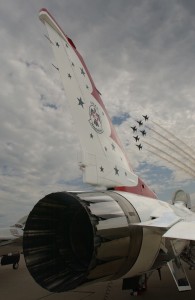
A spare U.S. Air Force Thunderbird F-16 Fighting Falcon stands ready as the 2006 demonstration team performs its trademark “Delta” maneuver.
In 1992, the team began flying the Lockheed Martin advanced F-16C with upgraded avionics and systems. It’s the only fighter to win both of the Air Force’s premier competitions: Gunsmoke for air to ground and William Tell for air superiority. The F-16D, the two-seat version, is used as a multi-role aircraft.
The F-16 fighter has remained the Thunderbirds’ aircraft of choice for the last 24 years, the longest performance era of any one type. It’s a star performer for the Thunderbirds, the Air Force and the 24 other nations whose boundaries it patrols and defends.
Today’s team
Today, the Thunderbirds squadron is an Air Combat Command unit composed of eight pilots (including six demonstration pilots), four support officers, three civilians and more than 130 enlisted personnel performing in 25 career fields.
A Thunderbirds air demonstration is a mixture of formation flying and solo routines. The four-aircraft diamond formation demonstrates the training and precision of Air Force pilots, while the solo aircraft highlight the maximum capabilities of the F-16. For each air show, the pilots perform about 30 maneuvers in 75 minutes. The season schedule lasts from March to November, with the winter months used to train new members.
The men and women from the 2007 team have diverse backgrounds. Lt. Col. Kevin Robbins, 41, from Winter Haven, Fla., is the commander leader, in his second season flying the #l jet in the lead position of the diamond formation. He entered the Air Force in 1988 as a distinguished graduate from Officer Training School at Lackland AFB in Texas and has an MS from American Military University. He’s logged more than 3,700 total hours as an Air Force pilot, with more than 250 hours of combat experience and 3,400 hours in the F-15A/B/C/D and F-16C/D.
Maj. Chris Austin, 34, from Huntington Beach, Calif., is in his first season flying the #2 jet as the left wing position in the diamond formation. He entered the Air Force in 1995 after graduating from the Air Force Academy in Colorado Springs, Colo. He’s logged more than 1,900 total hours as an Air Force pilot, and has 1,700 hours in the F-16C/D.

The Thunderbird solos perform the opposing knife edge pass at Scott Air Force Base, Ill. The Thunderbirds perform more than 65 shows annually across the United States and abroad.
Maj. Nicole Malachowski, 32, from Las Vegas, is in her second season flying the #3 jet as the right wing position in the diamond formation. She entered the Air Force in 1996 after graduating from the Air Force Academy, with a BS in management and minor in French. She’s logged more than 1,700 hours in the F-15E and F-16C/D.
Maj. Scott Poteet, 33, from Durham, N.H., is in his first season flying the #4 jet as the slot position in the diamond formation. He entered the Air Force in 1996 as a distinguished graduate from the USAF ROTC Detachment at the University of New Hampshire with a BS in outdoor education. He’s logged more than 1,900 total hours as an Air Force pilot, and has more than 1,600 hours in the F-16.
Maj. Ed Casey, 33, from Sparta, N.J., is in his second season flying the #5 jet as the lead solo pilot. He entered the Air Force in 1995 upon graduation from the Air Force Academy with a BS in human factors engineering. He’s logged more than 2,400 total hours as an Air Force pilot, and has more than 2,100 hours in the F-16C/D.
Maj. Samantha Weeks, 31, from Rome, N.Y., is in her first season flying the #6 jet as the opposing solo pilot. She entered the Air Force in 1997 after graduating from the Air Force Academy with a BS in biology and has a master’s from the University of Oklahoma. Before her assignment to the Thunderbirds, she served as a flight commander and instructor pilot with the 12th Fighter Squadron at Elmendorf Air Force Base, Alaska. She’s logged more than 1,500 hours as an Air Force pilot, with more than 1,100 hours in the F-16C/D.
Maj. Rob Skelton, 37, from Rome, Ga., is in his first season flying the #7 jet as the operations officer. He entered the Air Force in 1991 as a distinguished graduate from the USAF ROTC Detachment at Samford University in Birmingham, Ala., with a BS in business administration. He’s logged more than 3,000 total hours as an Air Force pilot, and has more than 1,700 hours in the F-16.
Maj. Tad Clark, 33, from Seattle, is in his second season flying the #8 jet as the advance pilot/narrator. He ensures that all arrangements are complete, narrates each demonstration and flies media orientation flights in the F-16D. He entered the Air Force in 1996 after graduating from the Air Force Academy with a BS. He also has an MBA from Midwestern State University. He’s logged more than 2,200 total hours as an Air Force pilot, with more than 1,200 hours in the F-16C/D.
Maj. Dan Mirski, 36, from Palo Alto, Calif., is in his second season as the team’s flight surgeon. He entered the Air Force in 1992 from the Health Professions Scholarship Program after graduating from the University of California at Santa Barbara with a degree in business economics. In 1996, he earned a medical degree from Albany Medical College, N.Y. He completed his medical internship the following year at the West Los Angeles Veterans Administration/UCLA medical facility.
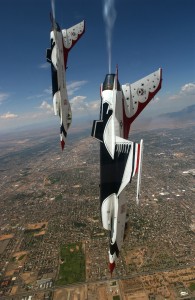
Viewed from the slot position, the Thunderbirds perform the delta loop over Kirtland Air Force Base, N. M.
Capt. Amy Glisson, 27, from Denver, is in her first season as the team’s executive officer. She entered the Air Force in 2001 after graduating from the Air Force Academy with a BS in political science. She supervises executive support, information management, budget, training and personnel selections. She also serves as squadron commander during the commander’s frequent deployments.
Capt. Charles Ploetz, 33, from San Antonio, is in his first season as the team’s maintenance officer. He entered the Air Force in 2000 through ROTC, after completing his master’s in environmental science at the University of Texas at San Antonio. He oversees nearly 90 aircraft maintenance personnel and is responsible for keeping the squadron’s fleet of 11 F-16s mission-ready. The squadron performs up to 88 demonstrations each year and has never canceled a demonstration due to maintenance difficulties.
Capt. Elizabeth Kreft, 27, from Union, Ky., is in her first season as the team’s public affairs officer. She entered the Air Force in 2002 after graduating from the U.S. Naval Academy with a BS in English. She oversees the Thunderbirds’ publicity and community relations programs.
A mental flight review
Maj. Samantha Weeks described her road to the Thunderbirds as one of following the rules and doing the right things at the right time. When asked how she prepares for her air demonstrations in an F-16C, flying the opposing solo position, Weeks explains that she often does mental flight reviews—even while sitting in a chair.
She has the high level of situational awareness needed to fly in close formation with other team members. Safety in the air and on the ground is always on her mind, with training in real airplanes under real world conditions.
For their air demonstration, Thunderbirds 1 through 4 do a formation takeoff, with Thunderbird 4 slot aircraft moving into position behind Thunderbird 1, just after getting airborne, creating the signature diamond formation. In their initial climb, they pass by the crowds and into a rolling turn at the departure end of the field, to set up for their first pass as the diamond clover loop.
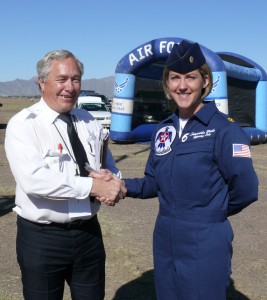
Bill Stansbeary, pilot and Airport Journals photographer, congratulates Maj. Samantha Weeks, U.S. Air Force Thunderbird 6, on her first air show performance of the season at Luke Days Air Show 2007 at Luke Air Force Base, Ariz.
Thunderbird 5 takeoff is next, performing a clean low-altitude aileron roll, followed by Thunderbird 6, which then does an inverted pass with a 360 aileron roll at show center. The solo pilots show the capabilities of the F-16C by doing maneuvers such as fast and slow passes and rolls and very tight turns.
Some of their maneuvers include both solo F-16s together, with opposing passes and mirror formations. The real crowd-pleaser seems to be the low- altitude, high-speed mirror formation calypso pass, with Thunderbird 5 flying inverted and Thunderbird 6 upright, in close-proximity flight.
Weeks described the life of a typical Thunderbird pilot, including a full schedule of activities. The team departs Nellis Air Force Base, near Las Vegas, early each Thursday morning, aboard an Air Force C-17 or C-5. Once at location, the team unloads and unpacks. Thursdays are generally reserved for media orientation and site survey flights. On Friday, the team usually visits schools and local hospitals and flies a practice show. The team may also meet with Make-A-Wish Foundation children and other special-needs children from the local communities and attends public relations events. Saturday and Sunday are show days.
On Monday, the team packs up and heads home. Tuesday is reserved for practice and administrative days in the hangar, and Wednesdays for attending to personal errands and family time. On Thursday, of course, the cycle begins again.
Since the precision flight team was formed in 1953, the Thunderbirds have flown 4,010 aerial demonstrations before more than 325 million people at air shows in all 50 states and more than 60 foreign counties.
For more information about the Thunderbirds, and their schedule, visit [http://www.thunderbirds.airforce.com].











